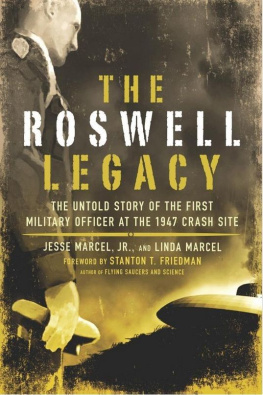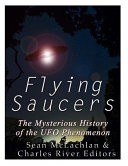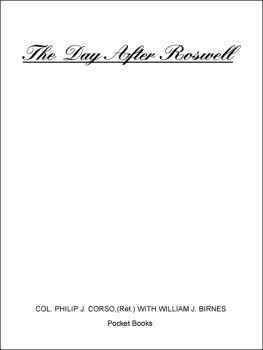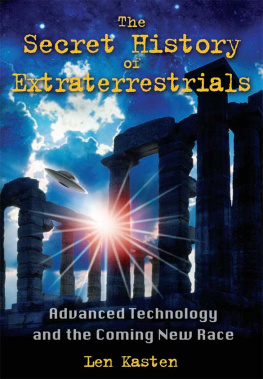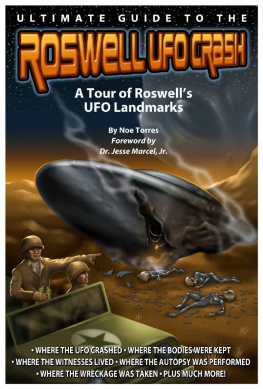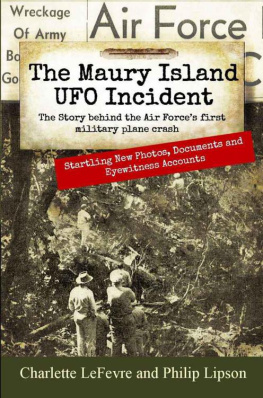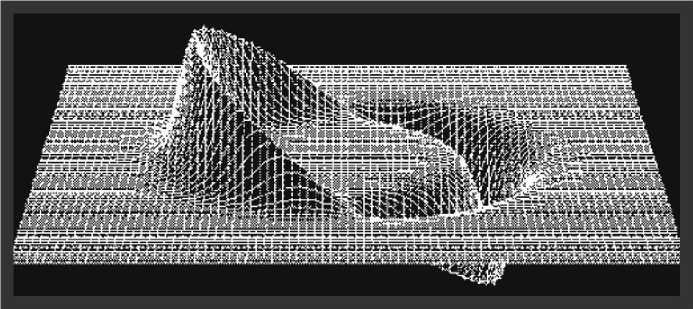Copyright 2009 by Jesse Marcel, Jr., and Linda Marcel
All rights reserved under the Pan-American and International Copyright Conventions. This book may not be reproduced, in whole or in part, in any form or by any means electronic or mechanical, including photocopying, recording, or by any information storage and retrieval system now known or hereafter invented, without written permission from the publisher, The Career Press.
The Roswell Legacy
Edited and typeset by Kara Reynolds
Cover design by Ian Shimkoviak, bookdesigners.com
Printed in the U.S.A.
To order this title, please call toll-free I-800-CAREER-1 (NJ and Canada: 201- 848-0310)
to order using MSA or MasterCard, or for further information on books from Career Press.
The Career Press, Inc., 220 West Parkway, Unit 12
Pompton Plains, NJ 07444
www.careerprcss.com
www.newpagebooks.com
Library of Congress Cataloging-in-Publication Data
Marcel, Jesse, 1938
The Roswell legacy : the untold story of the first military officer at the 1947 crash
site / hv Jesse Marcel, Jr. and I .inda Marcel; foreword by Stanton T Friedman.
p. cm.
Includes index.
ISBN 978-1 60163 026 1
1. Unidentified flying objectsSighting and encountersNew Mexico
Roswell. 2. Marcel, Jess. I. Marcel, I.inda. II. Title.
TL789.3.M355 2008
001.942 -dc22
2008027704
Chapter 10
Life in the Cosmos: Beyond Roswell
As I pointed out early in this book, I am not attempting to write the be-all and end-all work on the topic of extraterrestrial life, the technology involved in space travel, or even the final analysis of what happened near Roswell back in 1947. Those topics would require many tomes of far greater volume and depth than this one. Like my father before me, I have been filled with an insatiable scientific curiosity all my life, particularly on subjects arising from my early experiences. I have done extensive research in the areas of ufology, quantum physics, alien visitations and abductions, humans attempts to communicate with other worlds, and even the incredibly dynamic physical makeup of our own planet. (To give you an idea of the depth of my obsession with the latter, I once even built my own seismograph, with which I was able to measure earthquakes all over the world.) I wont bore you with all of the fascinating facts and theories I have encountered, but I do want to share a few tidbits of the work that has been and is being done to discover the answers to the question, Are we alone?
First, to give you a perspective of how vast the distances in the universe are, if the sun were the size of a period on this page, the Earth would be an invisible speck an inch away, and the nearest star would be 3/4 of a mile off. A passenger plane would take 5 million years to make the voyage to the nearest star, and it would take a billion years to walk it. These facts open the door to all kinds of problems with interstellar travel, which we will need major scientific breakthroughs to overcome. We know that some civilizations have made this leap, because they are visiting us from their parent systems. If they can do it, then we can and will, given time. Considering the insatiable human curiosity and our need to advance, I have no doubt that we will accomplish space travel and join other spacefaring civilizations soon enough.
Breakthroughs Necessary for Space Travel
A significant part of some peoples unwillingness to accept the existence of visitors from another world lies in the extraordinary distance between Earth and its closest potential neighbor. Although our modes of travel here on Earth-as well as our forays into our solar system-have progressed dramatically in our lifetime, we still rely upon technologies that are dependent upon a crude action-reaction process, and we comprehend speed in miles per hour, or, at best, feet per second. Travel to planets in other solar systems at speeds of which we are presently capable would take more years than have passed throughout all of humankinds recorded history. And even if we were to attempt a trip lasting many millennia, the amount of fuel we would have to carry would weigh more than we could even get off the ground, to say nothing of getting it high enough to escape Earths gravitational pull. To give an example of how daunting the challenge would be, the amount of rocket fuel it would take to propel a large bus to the nearest star in 900 years would outweigh the universe! And for those of you who immediately ask, Why not use a nuclear fission-powered rocket? it has been calculated that it would take a billion super-tankers full of nuclear fuel to get the bus to the nearest star in only 900 years. Of course, using a fusion-powered rocket would save an immense amount of weight, but such a rocket would still require a thousand supertankers filled with fuel. For those of you who are science fiction aficionados familiar with antimatter propulsion, it has been calculated that it would take merely 10 railway tanker cars filled with antimatter to make the trip, but we are still talking about a 900-year, one-way journey. Given these present limitations, it is not surprising that some people remain skeptical of the possibility that others have actually accomplished things that we have difficulty even imagining.
However, NASA has some out-of-the-box ideas about breaking the theoretical light-speed limit of special relativity, which states that any object with mass cannot exceed or even approach the speed of light. Although massive objects have to obey this rule, space itself is not limited to the speed of light, and can expand at any arbitrary pace, with no limit. The Alcubierre drive, named after its creator, Mexican physicist Miguel Alcubierre, who proposed the idea in a 1994 issue of the journal of Classical and Quantum Gravity, demonstrates this possibility In the Alcubierre drive, the space ahead of a spacecraft is compressed, while the space behind it is expanded. As a result, the space in which the craft is contained is pulled from ahead and pushed from behind. To an outside observer, the person in the craft would be traveling faster than light, but in the passengers capsule of space, he or she would feel no acceleration forces. For all practical purposes, he or she would be sitting still, while the immediate environment would be traveling at a speed that is-at least in theory-limitless. Because the craft embedded in this capsule of space is not subject to acceleration forces, its occupants would not be violently thrashed about during high-speed maneuvering. The catch is, contracting space in the front would take a huge amount of positive energy, and expanding space in the back would require an equal amount of negative energy. The technology for generating such immense levels of energy-not to mention proving even the existence of the phenomenon-does not currently exist on Earth, but might be possible within the realm of quantum physics, which civilizations on other worlds may well have already harnessed.
The following is a diagram of the distortion of space-time produced by the Alcubierre space drive.
Space-time warped by the Alcubierre drive.
One analogy of this capsule of space carrying its passenger faster than the surrounding space-time continuum is the moving sidewalk in an airline terminal. Visualize the moving sidewalk as the capsule with its passenger, and the fixed floor as the surrounding space-time. The moving sidewalk adds its forward speed to the passenger walking on it, so, to the passenger, he or she is walking at a normal speed, but still passes people walking on the fixed floor.
Next page
